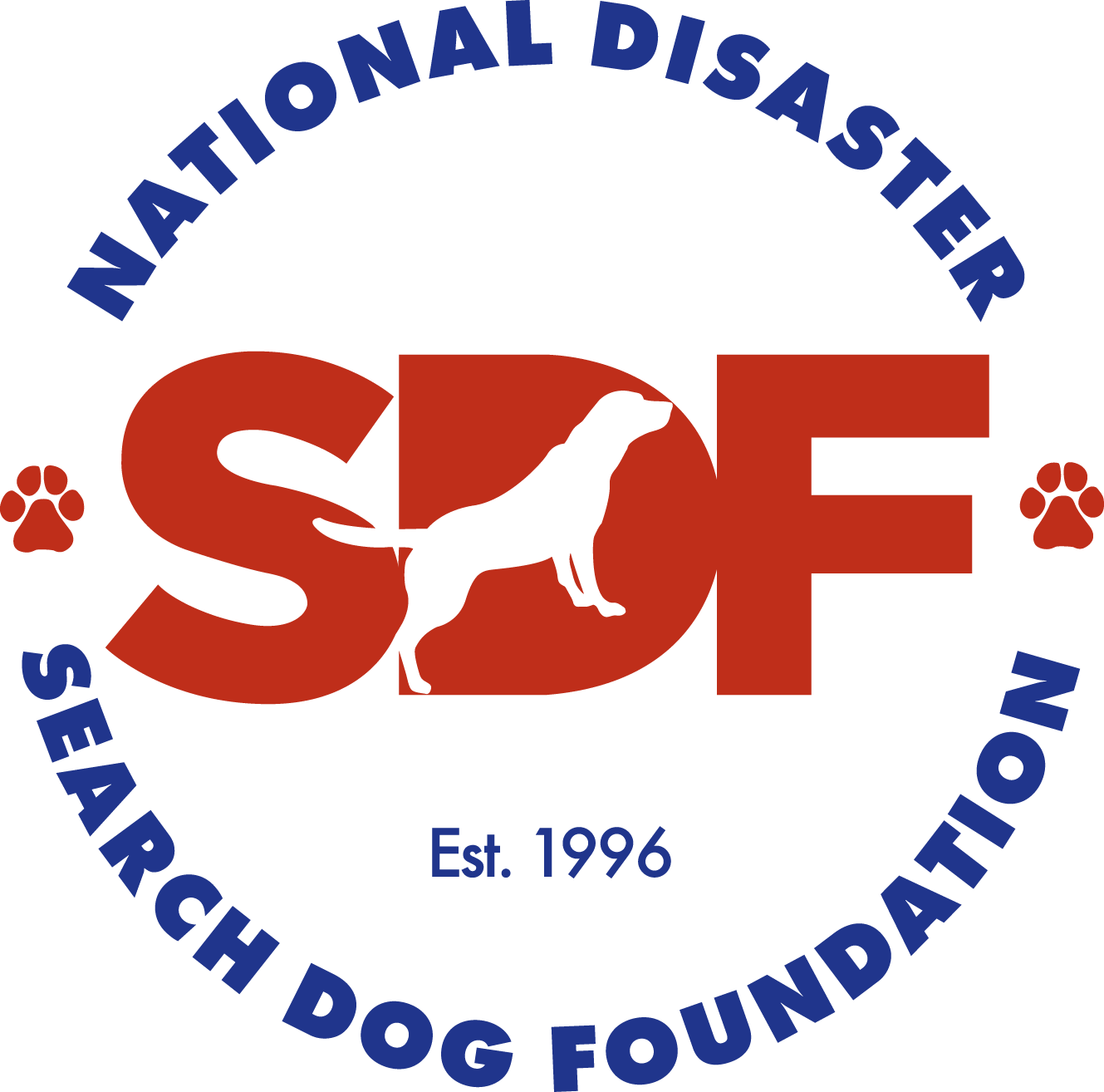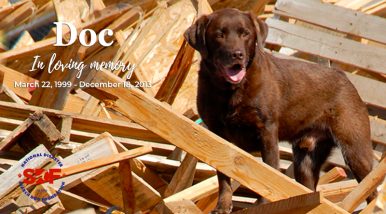High drive! What’s the downside of having too much energy? Well, if you’re a rambunctious Chocolate Lab puppy hoping to become a guide dog for the blind, you just might have to find another occupation! And that’s just what happened to MoDoc, a.k.a. Doc.
It all started in 1999. Doc, along with litter mates Mocha and Marc were bred by Guide Dogs of America (GDA) to become Guide Dogs.
As a GDA puppy-in-training, Doc joyfully lived with his foster mom, Mary Deets. Along with Mary’s other pets, he was part of a happy group which often traveled together to Lake Arrowhead, the High Sierras, Florida, San Francisco and Pennsylvania. They camped, swam, went on hikes. On less active days they went to bring cheer to the infirm and elderly as well as autistic children. Doc joined in all activities and was always well-behaved.
A year later, however, when they went for their evaluations by GDA, Doc and his siblings were labeled with “high drive”—dog lingo for being very energetic and busy-minded with a high prey-drive. These characteristics aren’t usually compatible with the serious focused work of a Guide Dog.
According to Kellee Matthews of GDA, this litter of Chocolates was very special. They were the “cutest little ones ever” and their foster families loved them and found them challenging, to say the least. “They were full of fun, fun, fun! We all kind of knew as they were maturing that they were not the norm for our program, so we had our eye on them for a while. We would never force a dog into a life of working for the blind if that dog displayed the will to do otherwise. Labradors love to please and, with that in mind, we thought we could give them an outlet for their natural drives in the field of search and rescue.”
Facing a career transition, Doc became a candidate for the Search Dog Foundation (SDF). Mary Deets continued to train Doc, now focusing on a search and rescue training regime. Doc trained with gusto and truly enjoyed his new calling. Mary found many activities to continually build Doc’s stamina and agility. He particularly enjoyed his swimming adventures in the High Sierras, always willing to dive deep to find and retrieve the stick.
Doc left Mary after about a year and continued his search-and-rescue training with Sundowners Kennels in Gilroy, where all SDF dogs trained at the time. Mary says of her time with Doc, “Doc was very loving, well-behaved and determined. He adjusted whether with children or elderly adults and was enjoyed by all.”
The trainers at Sundowners praised, “[Doc] is good on obstacles but needs more confidence on the rubble. He barks for the toy and at the alert tube. Obedience is his strong point. Doc is a fellow that really wants to please those that work with him. He does dynamic alerts and that is the core of what we need.”
Doc has other fans, too. Debra Tosch, SDF Executive Director, has a fond memory of Doc as a graduate from Sundowners. “I was very impressed with Doc…although he might have whined through the piles of rubble, he never quit.”
Doc was then teamed with Carrie Henger, a firefighter from Alta Loma, CA. Carrie rode a Harley and had an incredible zest for action. She was formerly a stunt woman and animal trainer before joining the Los Angeles County Fire Department at age 35. Her movie and TV credits include Police Academy 1 and 2, Hill Street Blues, American Gladiator, as well as numerous commercials. Carrie also has the distinction of being the first woman on the California Task Force 2 team (CA-TF2). She joined this task force with her first working dog Spanner, a very special and devoted yellow lab that was also trained as an arson canine. In fact, Carrie actually started the canine program with Spanner for the LA County Fire Department in 1994. Tragically, Spanner died in a traffic accident while on route to an FBI terrorist training at Vandenberg Air Force Base. But Carrie now trains with Doc and an arson specialist canine named Sprocket.
Carrie stated that Doc was not a “cuddler” like Spanner was, but “likes lying quietly next to me on the floor. Doc is obsessed with the toy, but doesn’t know how to pace himself…he will go ’til he drops!” Carrie proudly stated that Doc “gives 1000%, loves to play hard and tirelessly, and would swim 24 hours a day if he could.” His eyes “sank” when he got tired and Carrie then knew she had to hydrate him and make sure he paced himself. “He is always wagging his tail [and] loves people…all due to the great job Mary Deets did with him as a puppy raiser.”
Carrie and Doc were deployed to the Waterman Canyon mudslide in San Bernardino, sat at March Air Force Base trying to get to Iran to help after the earthquake, were used twice looking for missing people, assisted with search efforts at the deadly mudslide in La Conchita, California, and with rescue efforts in the aftermath of Hurricane Katrina. During the slow times, Carrie would demonstrate Doc’s capabilities to other firefighters who always came back from these demos in awe of what they’d witnessed. They’d go back to their own fire stations to spread the word, “Wow! That Chocolate Lab found me in less than a minute!”
Carrie and Doc were a great team and worked together until 2009, when Carrie was diagnosed with cancer. Sadly, the world lost a wonderful woman and canine handler on March 4, 2010. Carrie’s last wishes were that Doc and her arson detection dog, Sprocket, not be separated, and so Doc retired and lived out his remaining years in the loving home of Carrie’s husband, Bob.
At the age of 14 1/2, Doc peacefully crossed the Rainbow Bridge on December 18, 2013. Upon breaking the news of Doc’s passing, Bob told Debra Tosch, “He was a supremely fantastic dog and had such great drive even to the end, but his body couldn’t keep him going anymore. He was also the kindest dog I had ever been around.”
Thank you, Doc, for your wonderful work ethic and service to the nation. You will be missed but not forgotten.
Researched and Written by SDF Volunteer, Judy Friedman


